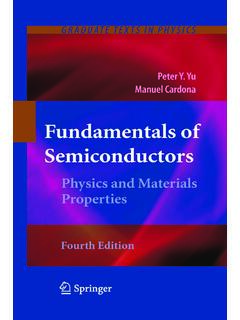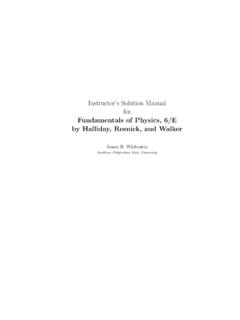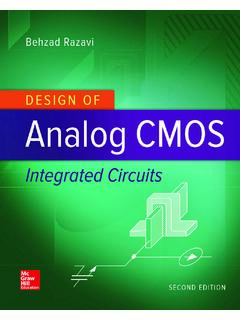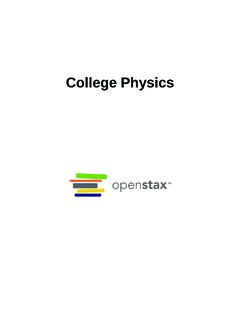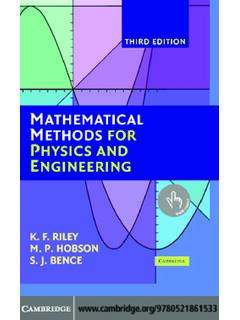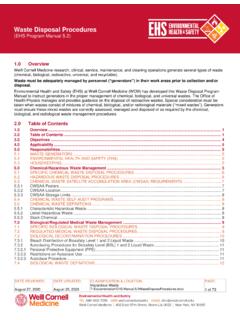Transcription of Classical Mechanics: a Critical Introduction
1 Classical mechanics : a Critical IntroductionMichael Cohen, Professor EmeritusDepartment of physics and AstronomyUniversity of PennsylvaniaPhiladelphia, PA 19104-6396 Copyright 2011, 2012with solutions Manual byLarry Gladney, J. and Louise W. Kahn Professor for Faculty ExcellenceDepartment of physics and AstronomyUniversity of Pennsylvania Why, a four-year-old child could understand out and find me a four-year-old child. - GROUCHOiREVISED PREFACE (Jan. 2013)Anyone who has taught the standard Introductory mechanics coursemore than a few times has most likely formed some fairly definite ideas re-garding how the basic concepts should be presented, and will have identified(rightly or wrongly) the most common sources of difficulty for the increasing number of people who think seriously about physics peda-gogy have questioned the effectiveness of the traditional classroom with theProfessor lecturing and the students listening (perhaps).
2 I take no positionregarding this question, but assume that a book can still have first draft of this book was composed many years ago and wasintended to serve either as a stand-alone text or as a supplementary tutor for the student. My motivation was the belief that most courses hurrythrough the basic concepts too quickly, and that a more leisurely discussionwould be helpful to many students. I let the project lapse when I found thatpublishers appeared to be interested mainly in massive textbooks coveringall of first-year that it is possible to make this material available on the Internetto students at the University of Pennsylvania and elsewhere, I have revivedand reworked the project and hope the resulting document may be usefulto some readers.
3 I owe special thanks to Professor Larry Gladney, whohas translated the text from its antiquated format into modern digital formand is also preparing a manual of solutions to the end-of-chapter Gladney is the author of many of these problems. The manualwill be on the Internet, but the serious student should construct his/her ownsolutions before reading Professor Gladney s discussion. Conversations withmy colleague David Balamuth have been helpful, but I cannot find anyoneexcept myself to blame for errors or defects. An enlightening discussion withProfessor Paul Soven disabused me of the misconception that Newton s FirstLaw is just a special case of the Second Creative Commons copyright permits anyone to download and re-produce all or part of this text, with clear acknowledgment of the the text, nor any part of it, may be sold.
4 If you distribute all orpart of this text together with additional material from other sources, pleaseidentify the sources of all materials. Corrections, comments, criticisms, ad-ditional problems will be most welcome. Cohen, Dept. of physics and Astronomy, Univ. of Pa.,Phila, PA 19104-6396email: IntroductionClassical mechanics deals with the question of how an object moves when itis subjected to various forces, and also with the question of what forces acton an object which is not word Classical indicates that we are not discussing phenomena onthe atomic scale and we are not discussing situations in which an objectmoves with a velocity which is an appreciable fraction of the velocity oflight.
5 The description of atomic phenomena requires quantum mechanics ,and the description of phenomena at very high velocities requires Einstein sTheory of Relativity. Both quantum mechanics and relativity were inventedin the twentieth century; the laws of Classical mechanics were stated by SirIsaac Newton in 1687[New02].The laws of Classical mechanics enable us to calculate the trajectoriesof baseballs and bullets, space vehicles (during the time when the rocketengines are burning, and subsequently), and planets as they move aroundthe sun. Using these laws we can predict the position-versus-time relationfor a cylinder rolling down an inclined plane or for an oscillating pendulum,and can calculate the tension in the wire when a picture is hanging on practical importance of the subject hardly requires demonstrationin a world which contains automobiles, buildings, airplanes, bridges, andballistic missiles.
6 Even for the person who does not have any professionalreason to be interested in any of these mundane things, there is a compellingintellectual reason to study Classical mechanics : this is the exampleparexcellenceof a theory which explains an incredible multitude of phenomenaon the basis of a minimal number of simple principles. Anyone who seriouslystudies mechanics , even at an elementary level, will find the experience atrue intellectual adventure and will acquire a permanent respect for thesubtleties involved in applying simple concepts to the analysis of simple wish to distinguish very clearly between subtlety and trickery.
7 There is no trickery in this subject. Thesubtletyconsists in the necessity ofusing concepts and terminology quite precisely. Vagueness in one s think-ing and slight conceptual imprecisions which would be acceptable in every-day discourse will lead almost invariably to incorrect solutions in most introductory physics courses approximately one semester (usu-ally a bit less than one semester) is devoted to mechanics . The instructorand students usually labor under the pressure of being required to cover Introduction certain amount of material. It is difficult, or even impossible, to cover thestandard topics in mechanics in one semester without passing too hastilyover a number of fundamental concepts which form the basis for everythingwhich the most common area of confusion has to do with the listing ofthe forces which act on a given object.
8 Most people require a considerableamount of practice before they can make a correct list. One must learnto distinguish between the forces acting on a thing and the forces which itexerts on other things, and one must learn the difference between real forces(pushes and pulls caused by the action of one material object on another)and demons like centrifugal force (the tendency of an object moving in acircle to slip outwards) which must be expunged from the list of impatient reader may be annoyed by amount of space devoted todiscussion of obvious concepts such as force , tension , and friction.
9 The reader (unlike the student who is trapped in a boring lecture) is, ofcourse, free to turn to the next page. I believe, however, that life is longenough to permit careful consideration of fundamental concepts and thattime thus spent is not a few additions (some discussion of waves for example) this bookcan serve as a self-contained text, but I imagine that most readers woulduse it as a supplementary text or study guide in a course which uses anothertextbook. It can also serve as a text for an online chapter includes a number of Examples, which are problems re-lating to the material in the chapter, together with solutions and relevantdiscussion.
10 None of these Examples is a trick problem, but some containfeatures which will challenge at least some of the readers. I strongly recom-mend that the reader write out her/his own solution to the Example beforereading the solution in the introductory mechanics courses are advertised as not requiring anyknowledge of calculus, but calculus usually sneaks in even if anonymously( in the derivation of the acceleration of a particle moving in a circleor in the definition of work and the derivation of the relation between workand kinetic energy).Since mechanics provides good illustrations of the physical meaning ofthe derivative and the integral , we introduce and explain these mathe-matical notions in the appropriate context.




